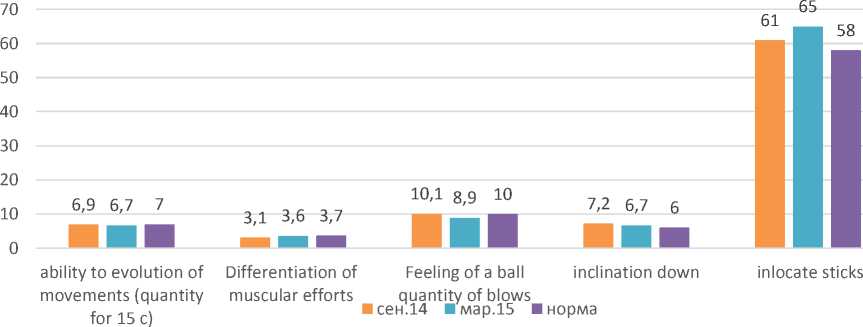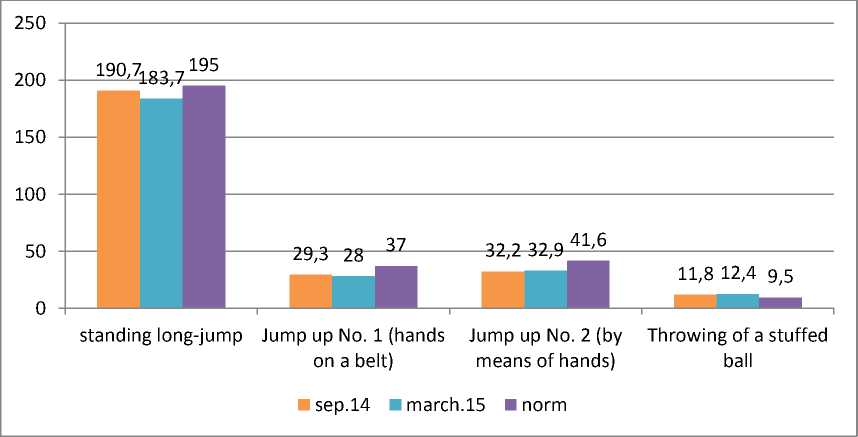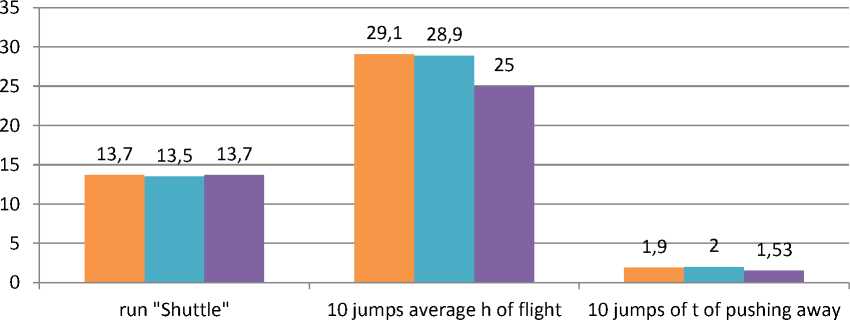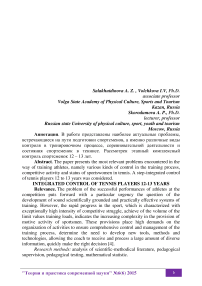Integrated control of tennis players 12-13 years
Автор: Salakhutdinova A.Z., Volchkova I.V., Skorodumova A.P.
Журнал: Теория и практика современной науки @modern-j
Рубрика: Основной раздел
Статья в выпуске: 6 (6), 2015 года.
Бесплатный доступ
The paper presents the most relevant problems encountered in the way of training athletes, namely various kinds of control in the training process, competitive activity and status of sportswomen in tennis. A step-integrated control of tennis players 12 to 13 years was considered.
Короткий адрес: https://sciup.org/140289290
IDR: 140289290
Текст научной статьи Integrated control of tennis players 12-13 years
Relevance. The problem of the successful performances of athletes at the competition puts forward with a particular urgency the question of the development of sound scientifically grounded and practically effective systems of training. However, the rapid progress in the sport, which is characterized with exceptionally high intensity of competitive struggle, achieve of the volume of the limit values training loads, indicates the increasing complexity in the provision of motive activity of sportsmen. These provisions place high demands on the organization of activities to ensure comprehensive control and management of the training process, determine the need to develop new tools, methods and technologies, allowing the coach to receive and process a large amount of diverse information, quickly make the right decision [4].
Research methods: analysis of scientific-methodical literature, pedagogical supervision, pedagogical testing, mathematical statistic.
The results of the research and their discussion. M.A. Godik believes that "the management of any process, including, for example, physical education person, includes 5 stages: collecting information on student and operational environment; analysis of information; drafting of the work program; work according to the program; monitoring the progress of implementation, making the necessary adjustments [1].
It is assumed that a directional change of the athlete's condition will lead to improved competitive outcomes, or to address local problems – improving individual aspects of preparedness of athletes, and it ultimately also has a positive impact on the sports results [2,3].
The program of integrated control includes three areas: monitoring competitive activity, monitoring of training activity, control of the athlete's condition [1].
The results of the survey are the basis of planning of training of work for the next stage of training.
On the basis of Kazan tennis Academy there is a systematic and complex stage of the survey (2 times a year) of members of the national team of RT in tennis and the nearest reserve. The step status monitoring of the player is performed with the use of complex tests and devices ("omega-sport", etc). Measured values of indicators allowing to assess the functional state of tennis, the speed, speed-power, coordination abilities, flexibility and stamina. The results of this survey are the basis of planning of training of work for the next stage of preparing.
There are the test results for the period September 2014 – March 2015 of athletes of 12-13 years:
Speed capabilities:
– the result of the speed of speed set is not changed and it is below the average one;
– the result in the women's 10 m is not changed and it is below the average one; – the result of the reaction is worsened, but it is above average one;

■ sep.14 ■ march.15 ■ norm
Fig.1 Results of stage control high-speed abilities of 12-13 year old tennis players
Speed-strength skills when the working legs are:
– the long jump is the result of degraded and is below the average one;
– the jump up (hands on waist) the result of degraded and it is below the average one;
–the jump up (with hands) – the result improve and is below the average one;
Speed-strength skills when working upper body:
– when throwing a stuffed ball are above average.

Fig. 3 Results of stage control, coordination abilities, flexibility of 12-13 year old tennis players

Fig.2 Results of staged control, speed-strength of 12-13 year old tennis players Coordination abilities:
– the indicator of the ability to rebuild movements deteriorated and is below average one;
– the indicator of the coherence is above the average level;
– the indicator of muscular efforts improved and is above average one;
– the indicator "feeling" of the ball deteriorated and is below average one. Flexibility:
– the overall flexibility is impaired, but it is below average;
– the indicator of the mobility of the shoulder joints deteriorated and it is below average.
Endurance:
– the indicator of anaerobic alactate endurance improved and it is below the average one;
– the average height of the 10 jumps jumping impaired, but it is above average one;
– t he time of repulsion, with 10 jumps is deteriorated and it is below average on e.

■ sep.14 ■ march.15 ■ norm
Fig. 4 Results of staged control of endurance of 12-13 year old tennis players
Conclusions . Thus, most of the results of staged control of athletes of 12-13 years old are below the average. You must plan for upcoming training work, to include in it parenting time for each to find effective means and methods. You need to make a correction in the training process – to review the total volume of work performed, the ratio of general and special training, tools and methods in the classroom for the general preparation and special.
Список литературы Integrated control of tennis players 12-13 years
- Godik, M.A., Integrated control in sports games / M. L. Old, A. II. Skorodumova. - M.: Soviet sport, 2010. - 336 p.
- Matveev, L.P. Theory and methodology of physical culture: Textbook. for in - tov NAT. cult. - M., 2006. - 394 p.
- Skorodumova, A.P. Construction of training qualified athletes in individual kinds of sports for example tennis: Dis.. d RA PED. Sciences: 13.00.04 Moscow, 1990. - 380 p.
- Fedorov, A.I. New information technologies in the system of higher physical education/ A.I.Fedorov, S.B.Karmanova //First Ural Forum "Culture, art and information at the turn of the third Millennium": book of reports. Vol. 1. - Chelyabinsk: Administration of Chelyabinsk Region. CSTI, 1996, - pp. 96-98.


